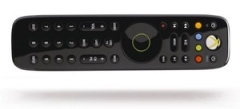About a year ago I moved to use Windows Media Center for my TV viewing at home. I planned on using the Xbox 360 as an extender, and was just stuck waiting for my backordered Ceton tuner to arrive. After months of waiting it showed up at my door, and the rest is history.
Fast forward to last month… I got my hands on the new Xbox 360 Media Remote, and loved the new look, the feel of the buttons, and the size. Something was missing though, I had become used to the Big Green Button on my other remote jumping right into Media Center. This remote had no Big Green Button, it had a live tv button, but that didn’t do anything useful. After being frustrated for a month with this design, I decided I’m going to try to make it better.
I don’t know a lot about hardware hacking, but I’ve replicated some hacks in the past done by other smart people. This device is small, cheap, and probably fairly simple in design. The price tag and complexity make this an ideal learning experience for me. So I got my screwdrivers and camera out, and began tearing it apart.
Six screws on the back of the remote, and the thing popped right open. Wow, pretty empty inside, a single board, no wires, nothing fancy at all. I tried to get some pictures to reference so that it would be a bit easier to inspect rather than trying to read the tiny print, and follow traces on the actual device. To my surprise they didn’t come out too bad, and I was able to clearly see several areas of interest. RX/TX pins, and what appears to be a clearly labeled JTAG interface. (Click image for GIANT size)
I immediately went to work with a razor blade scraping off the black covering to expose all the pads on the board. It appears Microsoft has pulled every pin that might be interesting out to an easily accessible location. The black covering scrapes off fairly easily as well. It is pretty clear that these boards were made as cheap as possible though, they are paper thin. That doesn’t matter, it just means they hopefully were cheap on the security of the chip as well.


